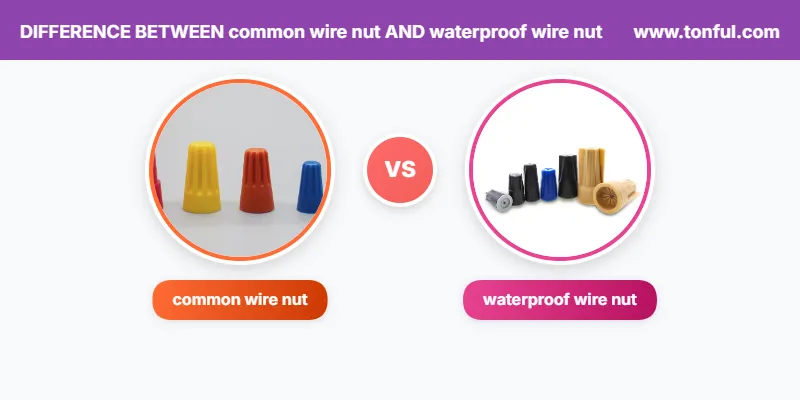When working with electrical projects, choosing the right wire connector can make the difference between a safe, long-lasting installation and potential safety hazards. Understanding the difference between common wire nuts and waterproof wire nuts is essential for any electrical work, whether you’re a DIY homeowner or professional electrician.
What Are Wire Nuts and Why Do They Matter?
Wire nuts, also known as twist-on wire connectors, are essential electrical components that safely join two or more electrical wires together. These small but critical devices provide both mechanical connection and electrical insulation, preventing dangerous short circuits, electrical fires, and shock hazards.
Before wire nuts became standard in the 1920s, electricians used time-consuming and potentially dangerous methods like soldering and taping wires together. Modern wire nuts revolutionized electrical work by offering a safer, faster, and more reliable solution for wire connections.
Common Wire Nuts: The Standard Choice for Indoor Applications
Construction and Design
Common wire nuts consist of an outer cap made from non-conductive plastic and an interior metal spring that serves as the gripping mechanism. When twisted over the stripped ends of electrical wires, the metal spring holds the wires tightly so the cap will not fall off and no wires will slip out of the splice.
Key Features of Standard Wire Nuts
Color-Coded Sizing System: Standard wire nuts are color-coded by the wire sizes they can fit. Standard wire nuts can be round, square, or have built-in wings to make twisting easier to do by hand.
Common color codes include:
- Gray: 22-16 AWG (small electronics, doorbells, thermostats)
- Blue: 22-14 AWG (light fixtures, small appliances)
- Orange: 22-14 AWG (fans, light fixtures)
- Yellow: 18-10 AWG (most common residential applications)
- Red: 18-10 AWG (larger wire combinations)
Material Properties: They’re usually made from a durable plastic that acts as insulation for the wires, and can withstand the heat generated by regular household electrical connections.
Best Applications for Common Wire Nuts
Standard wire nuts excel in:
- Indoor electrical installations
- Residential wiring projects
- Light fixture installations
- Switch and outlet connections
- HVAC system wiring
- Any dry location electrical work
Waterproof Wire Nuts: Enhanced Protection for Challenging Environments
Advanced Construction Features
Unlike traditional wire nuts, which rely on friction and pressure to secure wires together, waterproof variants feature a rubber or silicone sealant that creates a barrier against water ingress. This sealant not only prevents moisture from entering the connection but also helps maintain conductivity and insulation integrity over time.
Specialized Design Elements
Gel-Filled Interior: The gel in the nut will surround and protect the wire ends from outside substances. A waterproof wire connector is suitable for a wiring system that may be exposed to moisture.
Environmental Ratings: The waterproof end caps for electrical wire adopts IP65 waterproof design and pre-filled with the right amount of silicone sealant, which is weatherproof, moisture-proof and anti-corrosion, can be exposed to condensation, water, steam or dust.
Temperature Resistance: Quality waterproof wire nuts can operate in temperature ranges from -40°F to 400°F, making them suitable for extreme environmental conditions.
Types of Waterproof Wire Nuts
Silicone-Sealed Wire Nuts: These feature a flexible silicone material that forms a watertight barrier around the wires, perfect for various outdoor applications.
Gel-Filled Connectors: Pre-filled with dielectric grease or gel that expands around wire connections, providing superior moisture protection.
UV-Resistant Models: Many waterproof wire nuts are designed to be UV-resistant, ensuring that they can withstand prolonged exposure to sunlight without degrading.
Ideal Applications for Waterproof Wire Nuts
Outdoor Lighting Projects: When installing outdoor lighting fixtures, such as garden lights or pathway markers, waterproof wire nuts are essential for ensuring durable and weather-resistant connections.
Landscape and Irrigation Systems: When burying electrical cables underground for landscape lighting or irrigation systems, waterproof wire nuts provide an extra layer of protection against moisture and soil contaminants.
Pool and Water Feature Wiring: For wiring pond pumps, pool heaters, or fountain systems, waterproof wire nuts are a must-have to protect against water exposure.
Marine and Coastal Applications: The gel-filled varieties are particularly effective in saltwater environments where corrosion is a major concern.
Key Differences: Side-by-Side Comparison
Environmental Protection
Common Wire Nuts: Suitable only for dry, indoor locations. Standard wire nuts aren’t designed for outdoor use as they’re not weatherproof.
Waterproof Wire Nuts: Engineered for wet locations with IP65 or higher ratings, protecting against moisture, dust, and environmental contaminants.
Installation Differences
Standard Installation: Both types follow similar basic installation procedures, but waterproof versions have specific requirements.
Pre-Twisting Recommendations: One of the manufacturers of the wet location wire nuts said that they fail because people pre twist the wires. These wire nuts are filled with a type of gel. And you are not supposed to pre twist because it allows the conductors to be encapsulated by the gel when you insert them.
Cost Considerations
Standard wire nuts are significantly more affordable, while waterproof versions typically cost 3-5 times more due to their specialized materials and construction.
Reusability
Common Wire Nuts: Wire nuts are theoretically reusable, but there is ongoing debate about their reliability upon reuse.
Waterproof Wire Nuts: Generally designed for single-use applications, as removing them can compromise the sealing properties.
Installation Best Practices
For Common Wire Nuts
- Wire Preparation: Strip about 1/2 to 3/4 inch of insulation from the end of each wire with a wire stripper.
- Alignment: Hold wire ends flush together
- Optional Pre-Twisting: Twist wires clockwise with pliers for enhanced connection
- Installation: Place wire nut over ends and twist clockwise until tight
- Testing: Pull on the ends: Hold the wire nut with one hand. Grab the ends of the wires, one at a time, and make sure they’re seated and don’t come out of the splice.
For Waterproof Wire Nuts
- Wire Preparation: Strip approximately 1/2 inch of insulation
- No Pre-Twisting: Insert wires directly without pre-twisting to allow gel encapsulation
- Installation: No pre-twisting required, you just need to put the wire ends into the waterproof wire nut caps, and then twist the cap. The silicone sealant will overflow to seal the wire connection.
- Verification: Ensure sealant is visible at the base for proper waterproofing
Choosing the Right Wire Nut for Your Project
Use Common Wire Nuts When:
- Working in dry, indoor environments
- Cost is a primary consideration
- Standard residential electrical work
- Easy access for future modifications is needed
Choose Waterproof Wire Nuts When:
- Installing outdoor lighting or electrical systems
- Working in damp or wet locations
- Underground electrical installations
- Pool, spa, or water feature wiring
- Coastal or marine environments
- For outdoor lighting systems, garden installations, and even pools and hot tubs, using waterproof wire nuts ensures compliance with safety standards and enhances performance.
Safety Considerations and Code Compliance
Electrical Code Requirements
Wire connectors that are listed for wet locations are permitted by the code. You cannot tape up a wire nut that is not listed for a wet location and install it in a wet location.
Common Installation Mistakes
- Using standard wire nuts in wet locations
- Pre-twisting wires with gel-filled waterproof connectors
- Selecting incorrect size for wire gauge
- Failing to verify proper sealing on waterproof models
Maintenance and Troubleshooting
Regular Inspection Guidelines
Periodically check that wire nuts are still secure and show no signs of wear or damage. Replace any wire nuts that show signs of cracking, burning, or other damages immediately.
Signs of Failure
- Corrosion around connection points
- Loose or backing-off connectors
- Burning or melting of plastic housing
- Moisture infiltration in waterproof models
Cost-Benefit Analysis
Initial Investment vs Long-Term Value
While waterproof wire nuts cost significantly more upfront, they provide substantial value in appropriate applications by:
- Preventing costly electrical failures
- Reducing maintenance requirements
- Extending system lifespan
- Ensuring code compliance in wet locations
When Premium Investment Makes Sense
The extra cost of waterproof wire nuts is justified for any application where moisture exposure is possible, as the cost of replacing failed connections far exceeds the initial investment in proper components.
Conclusion
Understanding the difference between common wire nuts and waterproof wire nuts is crucial for electrical safety and system reliability. While standard wire nuts serve well for indoor applications, waterproof versions are essential for any location where moisture exposure is possible.
The key takeaway is simple: choose the right connector for your environment. Standard wire nuts work perfectly for dry indoor locations, while waterproof wire nuts are non-negotiable for outdoor, underground, or wet location installations. Investing in the appropriate connector type upfront ensures safer, more reliable electrical connections that will perform properly for years to come.
Remember to always follow local electrical codes and consider consulting a professional electrician for complex installations or when working with high-voltage applications. Proper wire nut selection and installation is a small but critical detail that can prevent serious safety hazards and system failures.

